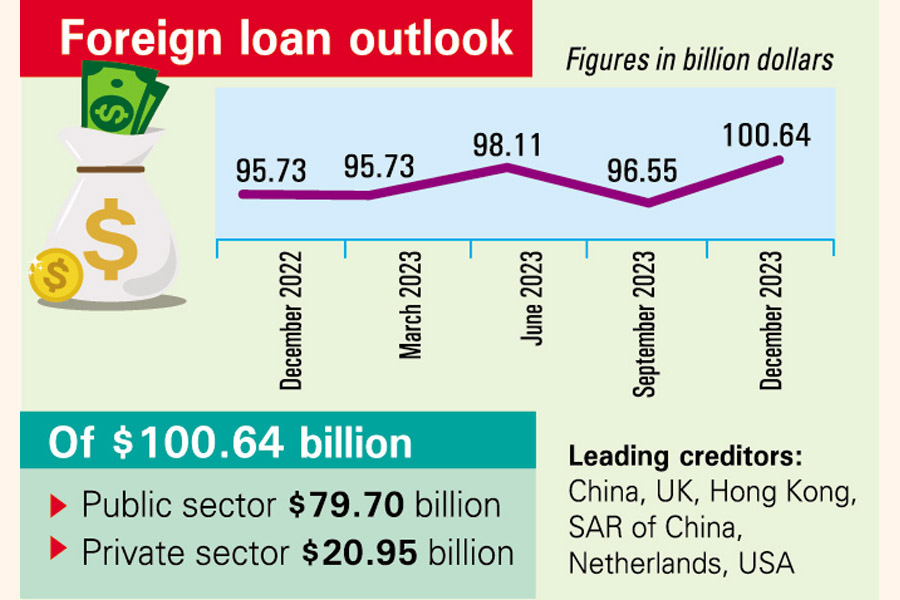
Published :
Updated :

Bangladesh's total external debt surpassed the $100 billion mark in December 2023 -- a rise of over 4.0 per cent, as this increase is primarily driven by a growing appetite for foreign funds especially by the public sector.
While the debt remains below the International Monetary Fund's (IMF) recommended ceiling, the current macroeconomic context, marked by a rapid depletion of foreign exchange reserves, causes concerns.
According to the latest Bangladesh Bank data, the country's overall outstanding external debt reached $100.64 billion by December 2023. This represents a 4.24 per cent increase from $96.55 billion in September and $98.11 billion in June of the same year.
The figures show a further increase from $95.73 billion and $96.51 billion in March 2023 and December 2022, respectively.
According to the central bank data, long-term debt stands at $86.41 billion, while short-term external borrowing is $14.23 billion.
The public sector holds the majority of the debt, at $79.70 billion, with the remaining $20.95 billion owed by the country's private sector.
In terms of country-wise external debts, China is the leading creditor nation, with Bangladesh owing $3.08 billion.
The United Kingdom follows at $1.03 billion, then Hong Kong and SAR of China $896 million, the Netherlands $840 million and the United States of America $735 million.
Speaking on condition of anonymity, a Bangladesh Bank official said the rise in external debt is due mainly to the government's increased borrowing to finance development activities.
When questioned about the growing external debt obligations, the central banker downplayed concerns, saying the long-term nature of most of the debt mitigates pressure on the economy.
"The country does not need to consider immediate repayment," the BB official said. "Repayment pressure will gradually increase over a longer period."
The official added Bangladesh's external debt-to-GDP ratio remains within the IMF's 40 per cent threshold.
According to official data, the country's external debt-to-GDP ratio reached 21.60 per cent in December 2023.
Contacted, East West University Economics Professor AK Enamul Haque said most foreign loans are used for public infrastructure development, with the government repaying them using the economic returns from these projects.
"So," Professor Haque said, "I am not concerned about the debt size itself. The key issue is whether it is used effectively to accelerate economic growth here."
Meanwhile, Professor MA Taslim of Independent University's Economics Department said the country will have to repay over $20 billion within a short timeframe.
Like Mr Haque, he too said the primary focus should be on whether the debt is used productively. "If the funds are not utilised for productive purposes or are misused, it will become a burden on the economy."
The noted economist believes increased investment in human capital development will undoubtedly boost workforce productivity, benefiting the economy in the long run.
"The crucial point, therefore, is where the debt goes and how efficiently the funds are used," he added.
jubairfe1980@gmail.com


 For all latest news, follow The Financial Express Google News channel.
For all latest news, follow The Financial Express Google News channel.